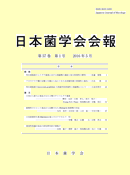
- |<
- <
- 1
- >
- >|
-
Daniel GUEZ, Eiji NAGASAWA2000Volume 41Issue 2 Article ID: jjom.H11-75
Published: 2000
Released on J-STAGE: October 13, 2020
JOURNAL FREE ACCESSA gasteromycete species, Mutinus elegans is recorded from Japan for the first time. It has been found in Takatsuki-shi, Osaka-fu (western Japan), fruiting in November and December in helio-thermophilous habitats (on the ground along paths or in open space), under or near bamboo (Phyllostachys bambusoides) and hardwoods (Quercus acutissima, Zelkova serrata, Cinnamomum camphora, etc.). A Japanese description and illustrations based on the studied material are presented.
View full abstractDownload PDF (521K) -
Katsuji YAMANAKA, Kenji NAMBA, Jun-ichi NAKANISHI2000Volume 41Issue 2 Article ID: jjom.H11-79
Published: 2000
Released on J-STAGE: October 13, 2020
JOURNAL FREE ACCESSThe morphological characteristics of black truffles harvested in Yunnan, China, were investigated. Ascocarps were collected in pure pine forests composed of mainly Pinus armandi mixed with P. yunnanensis. The forest soil was very poor, calcareous and purple, and its pH was 6.5-7.4. The fungus formed dichotomous ectomycorrhizas with fine roots of P. armandii. Ascocarps were 2-8(-10)cm in diam, and the peridium bore irregular polygonal, flattened warts with poorly defined radial splits. Ascospores were (20)-25-35-(40) x (14)-18-25-(32)μm (excluding spines). Spines were 4-6(-7)μm long, broad at the base, and often slightly hooked at the apex. Ascospores showed partial reticulation (pseudo-reticulum) by anastomosis of broad bases in a few spines. Yunnanese black truffles differ from T. himalayense, T. pseudohimalayense, and the Japanese black truffle, T. indicum, in morphology of the peridium and ascospore.
View full abstractDownload PDF (1055K)
- |<
- <
- 1
- >
- >|